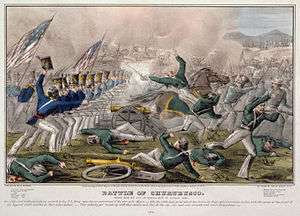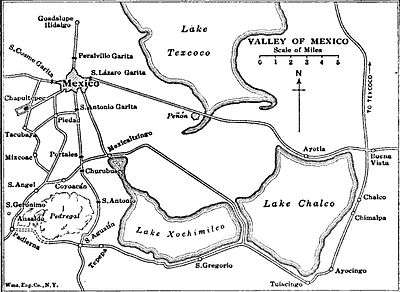Battle of Churubusco
The Battle of Churubusco took place on August 20, 1847, while Santa Anna's army was in retreat from the Battle of Contreras or Battle of Padierna during the Mexican–American War. It was the battle where the San Patricio Battalion, made up largely of American deserters, made their last stand against U.S. forces. The U.S. Army was victorious, outnumbering more than two-to-one the defending Mexican troops. After the battle, the U.S. Army was only 5 miles (8 km) away from Mexico City. About 50 of the captured San Patricio's were later hanged.
| Battle of Churubusco | |||||||
|---|---|---|---|---|---|---|---|
| Part of the Mexican–American War | |||||||
 Battle of Churubusco, J. Cameron, published by Nathaniel Currier | |||||||
| |||||||
| Belligerents | |||||||
|
|
| ||||||
| Commanders and leaders | |||||||
|
|
| ||||||
| Strength | |||||||
| 8,497[1]:301 | 3,800 | ||||||
| Casualties and losses | |||||||
|
133 killed 865 wounded 40 missing[1]:301 |
263 killed 460 wounded 1,831 captured[1]:301 | ||||||


Background
Following their defeats at Contreras Antonio de Padua María Severino López de Santa Anna y Pérez de Lebrón ordered Major General Nicolás Bravo Rueda with the Army of the Center to retreat from San Antonio to Churubusco.[1]:296 Santa Anna also ordered Major General Manuel Rincón to hold the Franciscan Convent of San Mateo in Churubusco, with earthworks and seven guns, and placed General Francisco Pérez at the tête de pont on the south bank of the river.[1]:296 Two regiments were placed along the river while the convent included the Bravo Battalions of the Mexico City National Guard and the San Patricio Battalion, plus Santa Anna formed a reserve along the highway to the north.[1]:296
Battle
Scott sent David Twiggs and Gideon Johnson Pillow's Divisions from San Angel to Coyoacán, while he ordered William Jenkins Worth to turn the San Antonio position.[1]:296 Worth sent Colonel Newman S. Clarke's Brigade and Lieutenant Colonel Charles Ferguson Smith's Light Battalion across the Pedregal lava field to the west of San Antonio, while Colonel John Garland faced San Antonio on the south.[1]:297
During retreat from San Antonio, the Mexican defenders (part of the 1st Line of Defense (or sometimes the "Army of the Center") with Colonel F. Villarreal and about 2,000 men: 700 of the "Hidalgo," 500 of the "Victoria" (Lieutenant Colonel P. Jorrin) National Guards Battalions, and 800 others: under Colonels A. Zerecero and J. G. Perdigón Garay), were struck in flank by Clarke's Brigade. Garland moved forward as the Mexicans withdrew from San Antonio and captured a General and four guns.[1]:297
Scott ordered an attack on the convent.[1]:297 In addition to the stone walls of the convent, the defenses included a series of incomplete trenches the Mexicans had begun digging prior to the attack.[4] Some elements of the Tlapa and Lagos Battalions arrived as reinforcements. Three cannon were placed on the right; two in the center; and the remaining two on the left. Independencia was assigned to defend the upper walls, the right flank leading to the bridge, the unfortified south and north sides, and two adobe huts further forward on the battlefield. The Bravos and the San Patricios were stationed on the left, behind barricades. In support along the Rio Churubusco was the Pérez Brigade: 2,500 men (11th Line, 1st, 3d & 4th Light Infantry Regiments).
Worth's division took on the tête de pont, while Twiggs' the convent.[1]:298 Rincón's gunners were able to force Taylor's battery to withdraw,[1]:298 and Perez's defense on the tête de pont twice repulsed Major Benjamin Louis Eulalie de Bonneville's 6th Infantry charge.[1]:298 The attack by Franklin Pierce and James Shields, crossing the river on the Coyoacan-Mixcoac road in an attempt to cut off the Mexican retreat, was also stopped.[1]:298 However, Worth turned the Mexican left and crossed the river, while the 8th and 5th Infantry took the tête de pont.[1]:300 Captain Duncan then set up a battery to attack the convent.[1]:300
Two of the Mexican cannons had melted and a third had fallen from its mount. Lieutenant Colonel Francisco Peñúñuri of Independencia led a handful of men in a bayonet charge and was defeated. He and Captain Luis Martínez de Castro, who had accompanied him, were killed in the battle. Officers from the Bravos attempted to raise the white flag over the convent walls on three occasions.[1]:300 They were prevented from doing so, however, by members of the San Patricios, who feared the fate that awaited them if they were taken prisoner.[5] They were ultimately captured and court-martialed for desertion, including the leader, John Patrick Riley. U.S. Captain James Milton Smith finally stopped the fighting by putting up a white handkerchief.[1]:300
Aftermath
The Americans captured 192 prisoners and three pieces of artillery at the tête de pont.[1]:300 They captured 1,259 prisoners, including three Generals and the San Patricios leader Lieutenant Colonel Francisco Rosenda Moreno, plus seven pieces of artillery at the convent.[1]:300 They captured another 380 prisoners further up the road.[1]:300
Seventy-two men of the San Patricios Battalion were court-martialed by the United States Army as deserters. Two separate courts martial were held, one at Tacubaya on 23 August, and another at San Ángel on 26 August. Fifty were sentenced to hang, having deserted after war had been declared. Those who had deserted earlier received 50 lashes. (See Saint Patrick's Battalion for a more complete description.)
When General Anaya was asked by General Twiggs to surrender his ammunition after the end of the battle, he replied, "If I had any ammunition, you would not be here".
Scott did not continue the pursuit into Mexico City, "...willing to leave something to this republic... I halted our victorious corps at the gates of the city."[1]:301
A Brigade of volunteers from New York was billeted to the convent, remaining there until September 7.
Gallery
 Battle of Churubusco, during the Mexican–American War, painting by Carl Nebel
Battle of Churubusco, during the Mexican–American War, painting by Carl Nebel Battle of Churubusco
Battle of Churubusco Map of the battle of Churubusco
Map of the battle of Churubusco Churubusco's monastery at the height of the 1847 Battle of Churubusco, painted by James Walker
Churubusco's monastery at the height of the 1847 Battle of Churubusco, painted by James Walker
In popular culture
Parts of the battle were portrayed in the 1985 ABC mini-series North and South, based on a trilogy of novels of the same name by John Jakes, as well as the film One Man's Hero (1999).
References
- Bauer, K.J., 1974, The Mexican War, 1846-1848, New York:Macmillan, ISBN 0803261071
- Smith, J. H., 1919, The War with Mexico, New York: Macmillan
- Smith, J. H., 1919, The War with Mexico, New York:Macmillan
- Ramsey (1850), pp. 292
- Pam Nordstrom, "SAN PATRICIO BATTALION," Handbook of Texas Online , accessed March 11, 2012. Published by the Texas State Historical Association.
Further reading
- Ramsey, Albert C. The other side; or, Notes for the history of the war between Mexico and the United States, New York: John Wiley 161 Broadway and 13 Paternoster Row, London, 1850
- Balbontin, Manuel " Recuerdos de la invasion norte-americana, 1846-1848.
- Annual Reports 1894, War Department lists trophy guns as:1- 16 pounder bronze, 4- 8 pounders, 4- 6 pounders and 3- 4 pounders.
External links
- A Continent Divided: The U.S. - Mexico War, Center for Greater Southwestern Studies, the University of Texas at Arlington